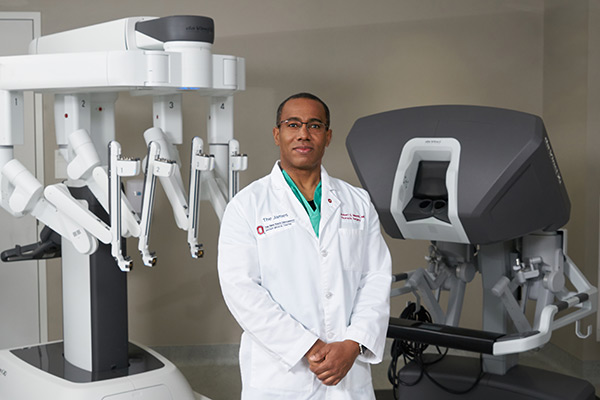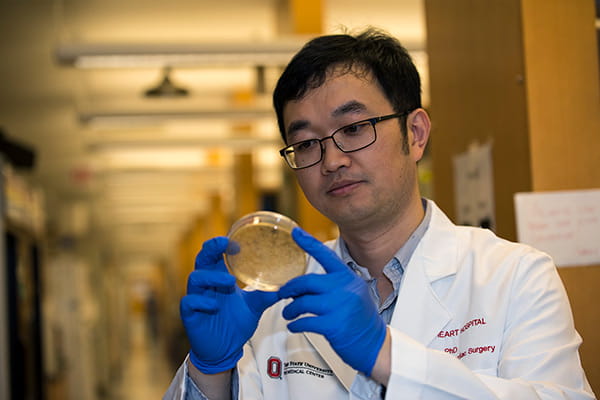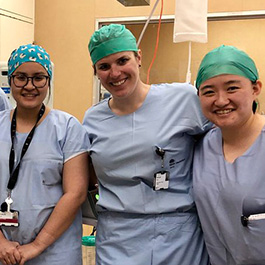Several new milestones achieved by the Department of Surgery at The Ohio State University Wexner Medical Center serve to illustrate its declared commitment to surgical innovation. “We have made deliberate plans related to clinical care, research and education to push our team to ongoing improvement and it’s paying off,” explains department chair, Timothy Pawlik, MD, PhD, MPH.
 Ohio State Wexner Medical Center has invested in robotic surgery and now claims the top spot as the nation’s fastest growing robotic surgery program. Several divisions and individual surgeons are instrumental to this rank, including the Thoracic Robotic Surgery program, which is one of the highest volume robotic surgery programs in the country. Particularly noteworthy is the 250+ robotic-assisted operations performed within the past year by thoracic surgeons Robert Merritt, MD, and Desmond D’Souza, MD. “Prior to 2017, the division performed only a few robotic procedures annually, so this definitely represents a dramatic increase,” says Dr. Pawlik. “In addition, our robotic curriculum for the thoracic surgery fellowship makes our program a destination for specialists.” Ohio State also claims the largest general surgery robotic program, led by David Renton, MD, and Michael Meara, MD. The OSUCCC – James and the Department of Surgery’s robotic pancreaticoduodenectomy, or “Whipple” program, is one of the nation’s highest-volume robotic programs of its type in the country. “All of these less invasive robotic surgeries are key to our goal of delivering cutting-edge care that helps patients recover faster and, most importantly, improves long-term outcomes,” says Pawlik.
Ohio State Wexner Medical Center has invested in robotic surgery and now claims the top spot as the nation’s fastest growing robotic surgery program. Several divisions and individual surgeons are instrumental to this rank, including the Thoracic Robotic Surgery program, which is one of the highest volume robotic surgery programs in the country. Particularly noteworthy is the 250+ robotic-assisted operations performed within the past year by thoracic surgeons Robert Merritt, MD, and Desmond D’Souza, MD. “Prior to 2017, the division performed only a few robotic procedures annually, so this definitely represents a dramatic increase,” says Dr. Pawlik. “In addition, our robotic curriculum for the thoracic surgery fellowship makes our program a destination for specialists.” Ohio State also claims the largest general surgery robotic program, led by David Renton, MD, and Michael Meara, MD. The OSUCCC – James and the Department of Surgery’s robotic pancreaticoduodenectomy, or “Whipple” program, is one of the nation’s highest-volume robotic programs of its type in the country. “All of these less invasive robotic surgeries are key to our goal of delivering cutting-edge care that helps patients recover faster and, most importantly, improves long-term outcomes,” says Pawlik.
Ohio State’s surgery department has also pursued innovation through research and is now ranked #6 nationally in NIH Funding, the highest rank ever obtained by the department. Expansion of The Center for Surgical Health Assessment, Research and Policy (SHARP) and a number of breakthrough research projects by both MD and PhD surgeon scientists have driven this achievement. Calculated by the Blue Ridge Institute for Medical Research, the new ranking is due in part to many of the surgery faculty pursuing their research through SHARP, which supports exploration of research that can further equitable and cost-effective surgical care. Heena Santry, MD, has been instrumental in SHARP’s expansion.
 Other noteworthy contributors to Ohio State’s improved rank in research funding include two of the top 25 highest-funded principal investigators in FY2018 – Raphael Pollock, MD, at #5 with $5.02M and Jianjie Ma, PhD, at #21 with $2.35M – as well as the following Research Project Grants:
Other noteworthy contributors to Ohio State’s improved rank in research funding include two of the top 25 highest-funded principal investigators in FY2018 – Raphael Pollock, MD, at #5 with $5.02M and Jianjie Ma, PhD, at #21 with $2.35M – as well as the following Research Project Grants:
While discussing ongoing improvements in the surgery department, Pawlik is quick to emphasize the influence of several nationally and internationally known leaders who have joined Ohio State in the past year. This includes:
 “These leaders bring a tremendous energy and enthusiasm to our training,” says Pawlik, “which is perhaps their greatest contribution in the long-run because the entire surgery team at Ohio State is intensely dedicated to preparing the next generation of surgeons.” To expand on this, one training tool Pawlik highlights is a new OR coaching project, which is part of a larger education project started in April 2018 by E. Christopher Ellison, MD, to improve resident preparedness for independent surgery. Launched in partnership with Phoenix Chen, PhD, MS, the OR coaching portion includes active monitoring of each resident’s surgical skills and multi-source, multifaceted, procedure-specific feedback for chief residents within three days of each observed surgery. Pawlik also stresses Ohio State’s unique global surgery rotation program that features economically diverse destinations to foster a more well-rounded understanding of how healthcare is impacted by community. Rotations include both high and low to middle-income locations. Ohio State residents can spend one month in Australia, which provides significant exposure to many international experts who may become important ongoing mentors, or two weeks in Ethiopia to expand awareness for the resourcefulness and creativity often required in low to middle-income healthcare situations. Ultimately, both locations serve to better inform residents about policy changes and future surgical practices that may impact healthcare around the world.
“These leaders bring a tremendous energy and enthusiasm to our training,” says Pawlik, “which is perhaps their greatest contribution in the long-run because the entire surgery team at Ohio State is intensely dedicated to preparing the next generation of surgeons.” To expand on this, one training tool Pawlik highlights is a new OR coaching project, which is part of a larger education project started in April 2018 by E. Christopher Ellison, MD, to improve resident preparedness for independent surgery. Launched in partnership with Phoenix Chen, PhD, MS, the OR coaching portion includes active monitoring of each resident’s surgical skills and multi-source, multifaceted, procedure-specific feedback for chief residents within three days of each observed surgery. Pawlik also stresses Ohio State’s unique global surgery rotation program that features economically diverse destinations to foster a more well-rounded understanding of how healthcare is impacted by community. Rotations include both high and low to middle-income locations. Ohio State residents can spend one month in Australia, which provides significant exposure to many international experts who may become important ongoing mentors, or two weeks in Ethiopia to expand awareness for the resourcefulness and creativity often required in low to middle-income healthcare situations. Ultimately, both locations serve to better inform residents about policy changes and future surgical practices that may impact healthcare around the world.
“Between new surgical techniques, the passion our researchers have for finding that next breakthrough and the daily collaboration I see at all levels, it’s been incredibly rewarding to work with all the experts who have helped our surgery department reach new milestones this year,” says Pawlik. “Going forward, Ohio State Department of Surgery will continue to push for improvements in clinical care, research and education – it’s a formula that not only works for us but a trifecta that gives patients the highest possible level of personalized care.”
 Ohio State Wexner Medical Center has invested in robotic surgery and now claims the top spot as the nation’s fastest growing robotic surgery program. Several divisions and individual surgeons are instrumental to this rank, including the Thoracic Robotic Surgery program, which is one of the highest volume robotic surgery programs in the country. Particularly noteworthy is the 250+ robotic-assisted operations performed within the past year by thoracic surgeons Robert Merritt, MD, and Desmond D’Souza, MD. “Prior to 2017, the division performed only a few robotic procedures annually, so this definitely represents a dramatic increase,” says Dr. Pawlik. “In addition, our robotic curriculum for the thoracic surgery fellowship makes our program a destination for specialists.” Ohio State also claims the largest general surgery robotic program, led by David Renton, MD, and Michael Meara, MD. The OSUCCC – James and the Department of Surgery’s robotic pancreaticoduodenectomy, or “Whipple” program, is one of the nation’s highest-volume robotic programs of its type in the country. “All of these less invasive robotic surgeries are key to our goal of delivering cutting-edge care that helps patients recover faster and, most importantly, improves long-term outcomes,” says Pawlik.
Ohio State Wexner Medical Center has invested in robotic surgery and now claims the top spot as the nation’s fastest growing robotic surgery program. Several divisions and individual surgeons are instrumental to this rank, including the Thoracic Robotic Surgery program, which is one of the highest volume robotic surgery programs in the country. Particularly noteworthy is the 250+ robotic-assisted operations performed within the past year by thoracic surgeons Robert Merritt, MD, and Desmond D’Souza, MD. “Prior to 2017, the division performed only a few robotic procedures annually, so this definitely represents a dramatic increase,” says Dr. Pawlik. “In addition, our robotic curriculum for the thoracic surgery fellowship makes our program a destination for specialists.” Ohio State also claims the largest general surgery robotic program, led by David Renton, MD, and Michael Meara, MD. The OSUCCC – James and the Department of Surgery’s robotic pancreaticoduodenectomy, or “Whipple” program, is one of the nation’s highest-volume robotic programs of its type in the country. “All of these less invasive robotic surgeries are key to our goal of delivering cutting-edge care that helps patients recover faster and, most importantly, improves long-term outcomes,” says Pawlik.Ohio State’s surgery department has also pursued innovation through research and is now ranked #6 nationally in NIH Funding, the highest rank ever obtained by the department. Expansion of The Center for Surgical Health Assessment, Research and Policy (SHARP) and a number of breakthrough research projects by both MD and PhD surgeon scientists have driven this achievement. Calculated by the Blue Ridge Institute for Medical Research, the new ranking is due in part to many of the surgery faculty pursuing their research through SHARP, which supports exploration of research that can further equitable and cost-effective surgical care. Heena Santry, MD, has been instrumental in SHARP’s expansion.
 Other noteworthy contributors to Ohio State’s improved rank in research funding include two of the top 25 highest-funded principal investigators in FY2018 – Raphael Pollock, MD, at #5 with $5.02M and Jianjie Ma, PhD, at #21 with $2.35M – as well as the following Research Project Grants:
Other noteworthy contributors to Ohio State’s improved rank in research funding include two of the top 25 highest-funded principal investigators in FY2018 – Raphael Pollock, MD, at #5 with $5.02M and Jianjie Ma, PhD, at #21 with $2.35M – as well as the following Research Project Grants:- Bryan Whitson, MD, PhD – R01 for “Preservation and Rescue of The Lung Donor Allograft for Transplantation”
- Ginny Bumgardner, MD, PhD – T32 for “Advanced Research Training in Immunology for Surgery Trainees (ARTIST)”
- Peter Lee, MD, PhD – K08 for “Tissue engineering skeletal muscle delivering a myokine protein to treat volumetric muscle loss”
- Hua Zhu, PhD – R01 for “Regulation of Mitsugumin 29 expression in muscle physiology and diseases”
- Lian-Wang Guo, PhD – R01 for “BET Bromodomain proteins as Novel Epigenetic Targets for prevention of Intimal Hyperplasia after Vascular Surgery”
While discussing ongoing improvements in the surgery department, Pawlik is quick to emphasize the influence of several nationally and internationally known leaders who have joined Ohio State in the past year. This includes:
- Amalia Cochran, MD, vice chair for Education, who also serves as Vice president of the Association of Women Surgeons, President of the Association for Surgical Education, member of the ACS Board of Governors, and Fellow of both the American College of Surgeons (ACS) and the American College of Critical Care Medicine
- Stacy Brethauer, MD, FACS, FASMBS, vice chair of Quality and Patient Safety and professor of Surgery in the Division of General and GI Surgery, who has fulfilled every leadership board position and many committee member positions for the American Society for Metabolic and Bariatric Surgery (ASMBS), the largest national society for his specialty
- Nahush Mokadam, MD, FACC, FACS, the Gerard S. Kakos MD and Thomas E. Williams, Jr., MD, PhD, Professor and division director for Cardiac Surgery, an international leader in heart failure who specializes in heart transplants and ventricular assist devices with the clinical trial experience that will help expand the availability of novel and innovative cardiac treatment options at Ohio State
- Benjamin Poulose, MD, MPH, the Robert M. Zollinger Chair of Surgery, funded by the LeCrone-Baxter Memorial Fund, and director of the Division of General and Gastrointestinal Surgery, who is an abdominal wall core reconstruction specialist and also President of Americas Hernia Society (AHS)
- Allan Tsung, MD, the John L. Marakas Nationwide Insurance Enterprise Foundation Chair in Cancer Research, and director of Surgical Oncology, as well as President of the Society of University Surgeons and leader for the Society of Surgical Oncology, the Society of Asian Academic Surgeons, the Americas Hepato-Pancreato-Biliary Association and the American Association for the Study of Liver Diseases
 “These leaders bring a tremendous energy and enthusiasm to our training,” says Pawlik, “which is perhaps their greatest contribution in the long-run because the entire surgery team at Ohio State is intensely dedicated to preparing the next generation of surgeons.” To expand on this, one training tool Pawlik highlights is a new OR coaching project, which is part of a larger education project started in April 2018 by E. Christopher Ellison, MD, to improve resident preparedness for independent surgery. Launched in partnership with Phoenix Chen, PhD, MS, the OR coaching portion includes active monitoring of each resident’s surgical skills and multi-source, multifaceted, procedure-specific feedback for chief residents within three days of each observed surgery. Pawlik also stresses Ohio State’s unique global surgery rotation program that features economically diverse destinations to foster a more well-rounded understanding of how healthcare is impacted by community. Rotations include both high and low to middle-income locations. Ohio State residents can spend one month in Australia, which provides significant exposure to many international experts who may become important ongoing mentors, or two weeks in Ethiopia to expand awareness for the resourcefulness and creativity often required in low to middle-income healthcare situations. Ultimately, both locations serve to better inform residents about policy changes and future surgical practices that may impact healthcare around the world.
“These leaders bring a tremendous energy and enthusiasm to our training,” says Pawlik, “which is perhaps their greatest contribution in the long-run because the entire surgery team at Ohio State is intensely dedicated to preparing the next generation of surgeons.” To expand on this, one training tool Pawlik highlights is a new OR coaching project, which is part of a larger education project started in April 2018 by E. Christopher Ellison, MD, to improve resident preparedness for independent surgery. Launched in partnership with Phoenix Chen, PhD, MS, the OR coaching portion includes active monitoring of each resident’s surgical skills and multi-source, multifaceted, procedure-specific feedback for chief residents within three days of each observed surgery. Pawlik also stresses Ohio State’s unique global surgery rotation program that features economically diverse destinations to foster a more well-rounded understanding of how healthcare is impacted by community. Rotations include both high and low to middle-income locations. Ohio State residents can spend one month in Australia, which provides significant exposure to many international experts who may become important ongoing mentors, or two weeks in Ethiopia to expand awareness for the resourcefulness and creativity often required in low to middle-income healthcare situations. Ultimately, both locations serve to better inform residents about policy changes and future surgical practices that may impact healthcare around the world.“Between new surgical techniques, the passion our researchers have for finding that next breakthrough and the daily collaboration I see at all levels, it’s been incredibly rewarding to work with all the experts who have helped our surgery department reach new milestones this year,” says Pawlik. “Going forward, Ohio State Department of Surgery will continue to push for improvements in clinical care, research and education – it’s a formula that not only works for us but a trifecta that gives patients the highest possible level of personalized care.”
